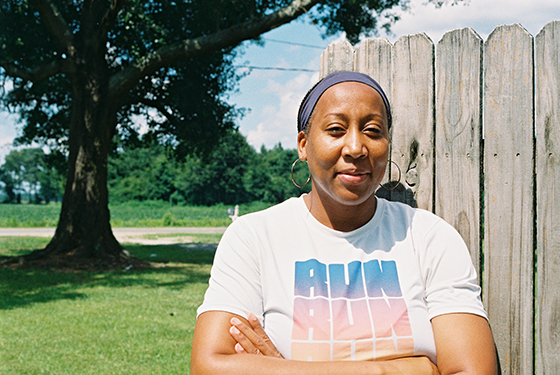| PHOTO | MELBA NEWSOME |
| Danielle Koonce, who grew up in rural Sampson County in southeastern North Carolina grew up surrounded by the stench of major hog farms and resulting water pollution, but hardly noticed it until studying environmental sociology in college raised her awareness. |
This three-part environmental justice series is made possible by a NABJ Black Press Grant supported by the Chan Zuckerberg Initiative.
In Sampson County, Black communities are repeatedly expected to shoulder the brunt of environmental burdens without reaping the benefits.
On July 12, nearly every seat in the county auditorium meeting room was occupied by 6 p.m. for a commissioners meeting. Most were there to support two people who signed up to speak during the public comment period about air and water pollution issues.
Elouise Stokes Jacobs lives in the unincorporated Waycross area near Clinton. She began her remarks to the five-member board tentatively but soon found her footing.
“Since they put a hog farm a quarter of a mile from where I live, we can’t drink the water or hang out our clothes,” she said. “I don’t even wear white clothes anymore because when you wash them, they turn yellow.
“In the late 1990s, Murphy’s hog farm tested my water. It was so bad they put a new well down which lasted about 10 years. I went back to them because we’re having the same problems all over again. They told me they weren’t gonna do anything else about my water, that I had to do it on my own. The county said there weren’t enough people on my road to put in water. How is it that we pay taxes and don’t have none of the services that should be provided to people?”
Jacobs’ rhetorical question is one that many Black residents in Sampson County want answered: Why are their communities always forced to shoulder the environmental burdens caused by industries that drive the economy but never reap the economic benefits?
Sparsely populated Sampson is North Carolina’s largest county by land mass. Over the past three decades, it has been overrun with industrial hog and poultry farms, wood pellet factories, a massive landfill and a soon-to-be-constructed 30-mile methane pipeline, all of which impact the air and water. According to the last census, Black people make up 26.6% of Sampson’s roughly 63,000 residents but the overwhelming majority of polluting industries are situated in communities of color.
County officials have given residents who are not connected to municipal water to distrust the groundwater. For several years, the health department posted a warning on the door of a church in the Taylor’s Bridge community: “MT ZION AME ZION CHURCH WATER HAS HIGH LEVELS OF NITRATE DO NOT GIVE THE WATER TO INFANTS UNDER 6 MONTHS OLD OR USE IT TO MAKE INFANT FORMULA.”
The small rural church of fewer than 100 members is surrounded by massive hog farms. The acres of corn feed crops are fertilized by spraying hog waste from the pits euphemistically called lagoons, a process common in predominantly Black communities in Duplin and Sampson counties, where hogs outnumber people 40 to 1.
The church was forced to spend nearly $4,000 to dig a new 225-feet well to avoid the nitrates caused when animal waste in the soil leaches into the groundwater. “Our only fault was being too close to a hog farm,” pastor Jimmy Melvin said. “The congregation has had to invest finances and time and energy towards a problem we did not create.”
Infrastructure inequity
Lakewood High School and Lakewood Country Club both have city water but the mostly black residents who live in the 3-mile stretch in between have been denied access for decades. The estimated cost of several million dollars to build the necessary infrastructure is prohibitive to residents and county commissioners say no taxpayer money can be used, either by connecting to municipal services or digging new wells to replace contaminated ones.
“Their rationale is that they’re using the money in the fastest-growing parts of the county along I-95 and I-44,” says Sherri White-Williamson, founder and director of the Environmental Justice Community Action Network, or EJ CAN. “That means that most of that water money is going to predominantly white parts of the county. They need to have at least 10 homes per mile to qualify for municipal water. That’s a tough marker to meet for rural communities.”
White-Williamson was born and raised in Clinton and spent more than a decade in Washington, D.C., in the Office of Environmental Justice for the U.S. Environmental Protection Agency. After retiring, she enrolled at the Vermont Law School and earned a law degree and a Masters of Energy Regulation. She returned to North Carolina in 2018 as environmental justice policy director for the North Carolina Conservation Network.
Safe drinking water is one of the many issues that prompted White-Williamson to focus more intently on Sampson County. It began with the 1,300-acre Sampson County landfill that takes in garbage from around the state and as far away as New York City including chemical waste and coal ash.
In Snow Hill, a once vibrant, business-oriented mostly Black community, residents who are not on county water worry that their wells are contaminated by groundwater toxins leaching from the dump site. They talk of brown ice cubes and being unable to garden or sit outside.
Eddie Williams’ family was here long before the landfill. Williams bought a patch of land in 1972 and built his house in 1973 after completing his military service. It’s a rare summer afternoon when there’s a break from the scorching heat and the pungent odors from the landfill and industrial hog farms nearby. He seizes the opportunity to sit outside in the shade of his carport.
“I get the smells from the landfills and when they take [hog waste] and pump it out on the fields,” Williams said. Oh lord and mercy!”
Williams was among the people who tried to fight the landfill before it turned Snow Hill into the state’s dumping ground.
“I remember when they first came here,” he said. “They had three meetings and I went to two of them. We met with them and asked them these words: ‘Well, you say you got to bring that landfill here. As big as Sampson County is, why can’t you just put it in an area with no houses around?’ They said they’d think about it but no, they had to put it right in a Black neighborhood.”
‘One frying pan to another’
Despite growing up surrounded by hog farms and drinking water problems, Danielle Koonce was only somewhat aware of the many environmental injustices happening in her own community.
“I was aware of this stench from the hog farm that was behind my grandmother’s house, and I was in high school when the landfill was established but I was really only thinking about Friday night football and going to college,” Koonce said. “It wasn’t until I took an environmental sociology class in college and so much of the literature was focused on Sampson and Duplin counties that I realized that everything I’ve been reading in textbooks and articles about environmental racism was happening right in my own county.”
Koonce is completing her PhD in sociology with a focus on racism and the environment at the University of Maryland. Her dissertation focuses on issues impacting the people and places where she grew up. When Koonce and her family moved back to Sampson during the pandemic, she got involved with local environmental activists.
Working with faculty and students from Appalachian State University, the group has provided free water testing for high levels of nitrates for more than 150 homes, while mapping the location of the hog farms and landfill in proximity to the highest levels of groundwater pollution.
“Some people say it’s too late now and, to some degree, they’re right but you still have to fight for the future because this could happen again to some other unsuspecting community,” says Koonce.

The next fight is already here. In 2018, Smithfield launched Align RNG, a joint venture with Dominion Energy, to convert waste from 19 farms into biogas and inject it into a Piedmont Natural Gas pipeline. The $30 million Grady Road project will capture and transport methane from the waste pits through a 30-mile pipeline across Duplin and Sampson counties for processing, potentially exposing nearby residents to more pollutants, including ammonia, hydrogen sulfide, and various volatile organic compounds.
Smithfield touts its biogas venture as a green energy solution that should be welcomed. But Will Hendrick, environmental justice advocate at NCCN, says the project will leave behind the billions of hog waste generated in a more potent form, worsening the groundwater impact.
CDC data on socially vulnerable communities and data from the U.S. Energy Information Administration show that pipelines are densest in the most socially vulnerable communities and an N.C. State University study shows they significantly increase public health risks.
Koonce and her family recently moved about 15 minutes away to Stedman in Cumberland County. But she hasn’t escaped the pressing environmental water issues. In 2017, the Chemours Company admitted to dumping the unregulated chemicals perfluoroalkyl and polyfluoroalkyl substances, or PFAS, into the Cape Fear River as far back as 1980.
Unlike many pollutants, PFAS builds up in the human body and even low concentration exposure has been linked to a wide range of cancers, diseases, and negative health effects. These “forever chemicals” made their way into the Haw River which supplies drinking water for many residents of Cumberland County. As part of a 2019 consent decree, Chemours was fined $12 million and ordered to help the affected residents.
“As soon as we moved into our home, the first piece of mail that I received was from the Chemours chemical company wanting to test our water,” she says. “I laughed because we can’t seem to get away from these water issues. It’s almost like I went from one frying pan to another.”
Comments
| I’m amazed that a Trump loving state like North Carolina that believes in America first. Allows itself to be run by China. Smithfield is run from China and literally owns the state of North Carolina with the amount of money they spend and its hurting black communities |
| Posted on October 9, 2021 |





